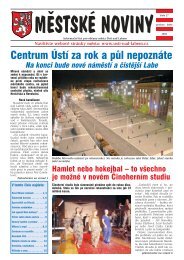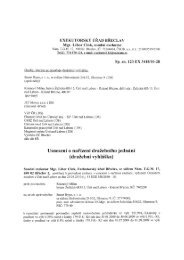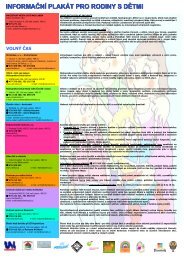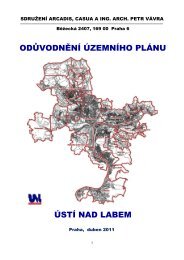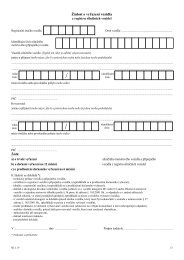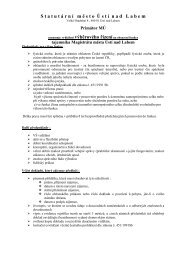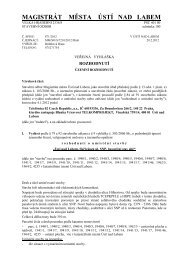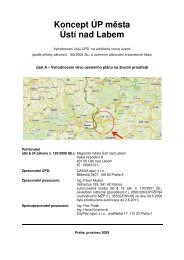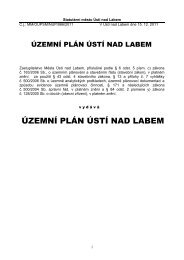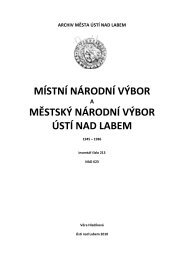Historie a památky města Ústí nad Labem History and monuments of ...
Historie a památky města Ústí nad Labem History and monuments of ...
Historie a památky města Ústí nad Labem History and monuments of ...
Erfolgreiche ePaper selbst erstellen
Machen Sie aus Ihren PDF Publikationen ein blätterbares Flipbook mit unserer einzigartigen Google optimierten e-Paper Software.
CZ ENG DE<br />
Výrazné bylo v <strong>Ústí</strong> a jeho okolí osídlení lužické kultury v mladší<br />
době bronzové (asi 1 250-1 000 př. n. l.) reprezentované sídlištními<br />
nálezy u Trmic a žárovým pohřebištěm ze Střekova. Na<br />
Ústecku nechybí ani doklady obývání prvních historicky známých<br />
etnik Keltů (500-40 př. n. l.) a Germánů. Poté, co zdejší<br />
území někdy v první polovině 6. století opustili, zůstala zdejší<br />
krajina po nějakou dobu neosídlená.<br />
From the new research:<br />
In 2006, several archaeological research projects took place in<br />
the city centre (on Mírové Square <strong>and</strong> at the corner <strong>of</strong> Dlouhá<br />
<strong>and</strong> Velká Hradební Streets). They discovered many new findings<br />
<strong>and</strong> moved/shifted?? the oldest known settlement <strong>of</strong> the<br />
centre <strong>of</strong> today´s <strong>Ústí</strong> <strong>nad</strong> <strong>Labem</strong> by many thous<strong>and</strong>s years<br />
backwards. Archaeologists discovered the remains <strong>of</strong> the settlements<br />
<strong>of</strong> the people <strong>of</strong> Linear Ceramics culture (5 500-4 900<br />
B.C..), i.e. the very first communities that produced <strong>and</strong> used<br />
ceramic pots. It was a big surprise to find bone fragments <strong>of</strong> a<br />
horse <strong>and</strong> an ox with a pelvis <strong>of</strong> a woolly mammoth; the found<br />
bones must have originally been lying on a waste pile, where<br />
people threw the remains <strong>of</strong> animals which could not be used<br />
any more.<br />
The descendants <strong>of</strong> the Linear Ceramics community were farmers<br />
with the Punched Ceramics Culture, who built the so called<br />
roundel , i.e. an area <strong>of</strong> a circular ground plan, on a moderate<br />
slope in the place <strong>of</strong> today´s town square around 4700<br />
B.C.. The roundel was enclosed with two concentric spiky trenches<br />
<strong>and</strong> presumably stockades, <strong>and</strong> it was used as an assembly<br />
place <strong>and</strong> for religious purposes. Building <strong>of</strong> the roundel<br />
required enormous efforts <strong>of</strong> more Neolithic communities<br />
around <strong>Ústí</strong>.<br />
From the new research:<br />
A detail <strong>of</strong> a spiky trench, restricting the Neolithic roundel in<br />
<strong>Ústí</strong> <strong>nad</strong> <strong>Labem</strong>.<br />
Photograph by Vladimír Hyke, Institute <strong>of</strong> Archaeological<br />
Monument Preservation <strong>of</strong> the North-Western Bohemia based<br />
in Most.<br />
A skeleton burial-ground <strong>of</strong> the Cord-marked Ceramics Culture<br />
(perhaps after 2600 B.C. <strong>of</strong> the Eneolithic period was discovered<br />
in the cadastral area <strong>of</strong> Trmice.<br />
<strong>Ústí</strong> <strong>and</strong> its surroundings had a significant settlement <strong>of</strong> Lusatian<br />
culture in the Early Bronze Age (about 1 250-1 000 B.C.)<br />
represented by the findings from the settlements near Trmice<br />
<strong>and</strong> cremation burial-place from Střekov. The <strong>Ústí</strong> region also<br />
has evidence <strong>of</strong> first historically known Celtic ethnic settlement<br />
(500-40 B.C.) as well as Germanic. After they have left the<br />
local territory sometime in the early 6th century, the territory<br />
remained unsettled for some time.<br />
Aus der neuen Erforschung:<br />
Detail des spitzeren Grabens, welcher das neolithische Rondell<br />
in <strong>Ústí</strong> <strong>nad</strong> <strong>Labem</strong> begrenzte.<br />
Foto: Vladimír Hyke, Institut für archäologische Denkmalpflege<br />
Nordwestböhmen in Most (Brüx).<br />
Aus der Jungsteinzeit (Neolithikum) wurde im Kataster Trmice<br />
(Türmitz) eine Skelettfundstätte aus der b<strong>and</strong>keramischen Kultur<br />
(ungefähr nach dem Jahre 2 600 v. Chr.) entdeckt.<br />
Sehr markant war in <strong>Ústí</strong> und der Umgebung die Besiedlung der<br />
Lausitzer Kultur in der jüngeren Bronzezeit (um 1 250-1 000 v.<br />
Chr.), repräsentiert durch Siedlungsentdeckungen bei Trmice<br />
(Türmitz) und durch eine Feuerbestattungsstätte in Střekov<br />
(Schreckenstein) . Es fehlen auch keine Nachweise in der Region<br />
<strong>Ústí</strong> <strong>nad</strong> <strong>Labem</strong> über Besiedlung der ersten historisch<br />
bekannten keltischen Volksgruppen (500-40 v. Chr.), sowie<br />
auch der Germanen. Nachdem sie das hiesige Gebiet irgendwann<br />
in der ersten Hälfte des 6. Jahrhunderts verlassen hatten,<br />
blieb die L<strong>and</strong>schaft hier für eine bestimmte Zeit unbesiedelt .<br />
7



